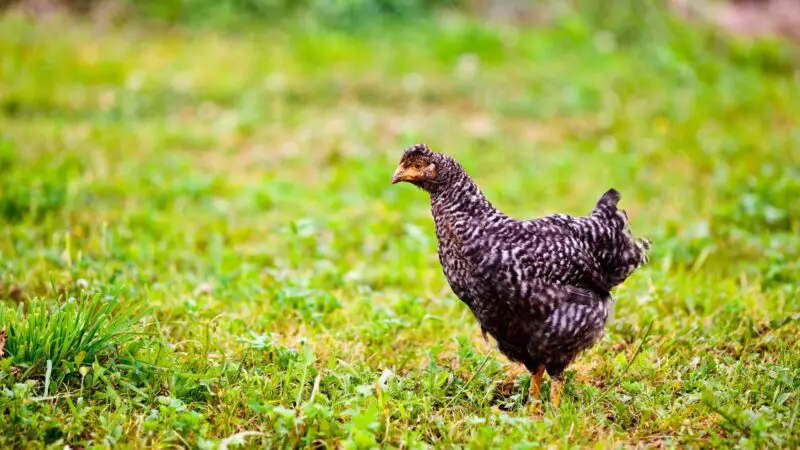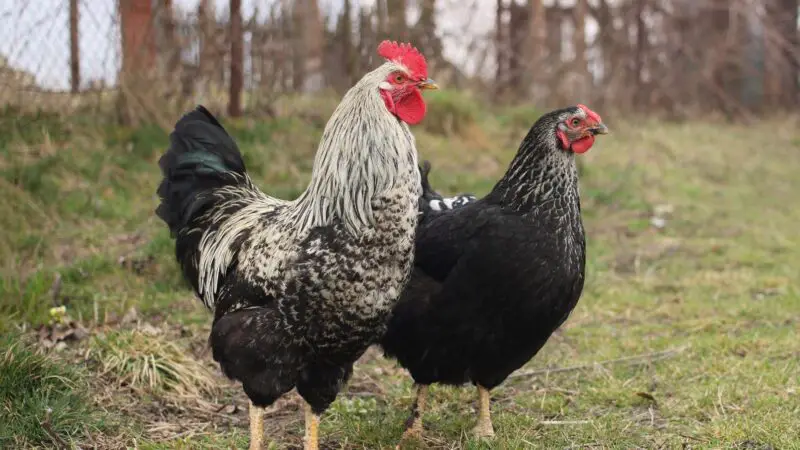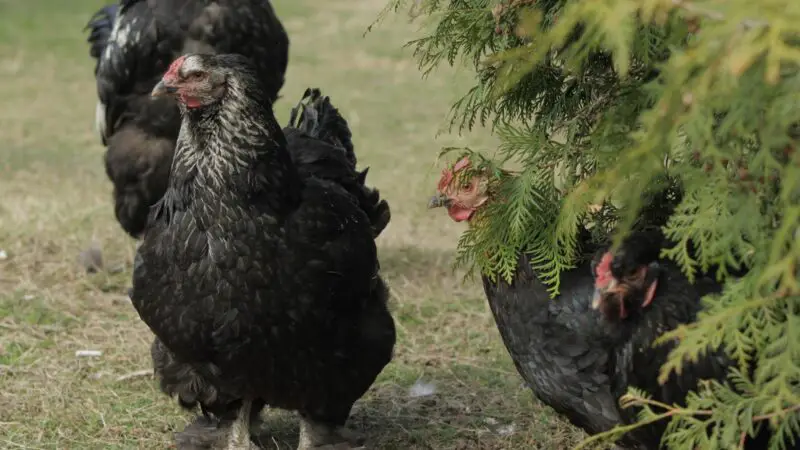The Java chicken is quite a majestic breed. With its black-and-white plumage and large build, it’s hard to miss. Because of its beauty, you might be curious as to its origins. Why isn’t it as common as other chickens? Is it a good egg layer? These are just some of the questions that come to mind.
The Java chicken is a rare American breed that’s noted for its sturdy appearance and beautiful glossy black and white plumage. This breed is a good egg layer and produces suitable meat, which is why it’s bred as a dual-purpose breed.
This discussion is just the tip of the iceberg. There’s so much more to learn about this old chicken breed. Lucky for you, this article will discuss everything you need to learn about Java chickens.
Java Chicken History

The Java chicken is one of the oldest chicken breeds in America. There are no exact records as to when Java chickens came to be – or which breed they came from.
However, it is known that they arrived in the United States around 1835 to 1850 from Asia. As to where in Asia, it is still uncertain; although it is believed that the breed came from Java, Indonesia – hence, the name.
By 1883, the Java chicken had been officially recognized by the American Poultry Association’s Standard of Perfection. This was also the time when the breed grew quite popular in the country, especially as a meat breed.
Over the years, the Java chicken was used to develop other American poultry breeds such as the Plymouth Rock, Jersey Giant, and Rhode Island Red chickens.
Unfortunately, with the rising popularity of these new chicken breeds, the Java chicken’s popularity started to decline. In fact, by the 1950s, Java chickens almost became extinct.
Fortunately, conservation efforts have been made to rescue the Java chicken breed. Today, it is still under Critical Status by The Livestock Conservancy but is regaining popularity.
What’s Special About Java Chickens?

The Java chicken is special because it is one of the oldest chicken breeds known to be created in the United States. In fact, it is second only to the Dominique Chicken.
Aside from being an old breed, Java chickens are also noted for their beautiful plumage. While some are black and some appear mottled, both share a common feature in their plumage: they have a beautiful iridescent sheen to their feathers. This makes them stand out among other chicken breeds.
Java Chicken Identification
What Do Java Chickens Look Like?
Java chickens are a large chicken breed characterized by their black or black-and-white mottled feathers with an iridescent green sheen to them. It has a red wattle and comb, which contrasts its dark-colored plumage. Java chickens are likewise easily distinguished owing to their broad backside and deep breast, giving them a more sturdy appearance.
The Java chicken generally has a pair of dark-colored eyes, yellow legs, and feet, as well as a hard black beak. However, other varieties of this bird also have reddish eyes and a reddish beak.
How Long Does a Java Chicken Live?
On average, the Java chicken can live for an average of eight to twelve years. It is known for being a hardy heritage breed, which is why it has a longer average lifespan than most chicken breeds.
What Do Java Chickens Eat?
Like most chickens, Java chickens are known for being excellent foragers. As such, their diet mostly consists of grains, vegetables, fruit, and cereals. They are also likely to eat small insects considered garden pests, such as grasshoppers and worms.
They may also eat store-bought pellets and grain mix to supplement what they forage. This is especially true for Java hens who need to be added calcium and protein during their lying cycle.
How Big Do Java Chickens Grow?
As earlier established, Java chickens are a large chicken breed. Roosters can grow as tall as 25 inches and weigh up to 9.5 pounds. On the other hand, hens can grow to around 10 to 20 inches and weigh between 6.5 to 7.5 pounds.
Are Java Chickens a Heavy Breed?
Java chickens are a heavy breed. Roosters can weigh up to 9.5 pounds, while hens can weigh up to 7.5 pounds.
Java Chicken Wingspan
The Java chicken has a wingspan ranging between 17 to 23 inches. While chickens are known mostly for being land dwellers, the Java chicken has an impressive wingspan that allows them to fly whenever it’s necessary.
What Is Java Chicken Known For?
The Java chicken is known for being a dual-purpose breed. In its early years, the Java chicken was mainly bred for its meat. In the long run, it has been observed that its hens are good egg layers. On average, a single hen can produce around 180 eggs in one year. Their eggs are also large-sized, making them in demand.
But aside from being a dual-purpose breed, the Java chicken is also popularly raised as a pet. Thanks to their calm and friendly demeanor, this chicken breed is great to have around children and other pets.
Interestingly, Java chicken is also used for chicken and poultry shows. Considering their unique heart-shaped body and beautiful plumage, Java chickens are also raised for exhibition purposes.
Where Do Java Chickens Originate?
While the Java chicken breed has been created and developed in the United States, its ancestors are from the Far East. It is unknown which country in the Far East specifically, but it is believed that its ancestors are chickens imported from the island of Java in Indonesia.
What Are the Distinct Characteristics of a Java Chicken?
There are two distinct features of the Java chicken that sets it apart from most chicken breeds. This includes its body type and feathers.
- Heart-shaped body. At first glance, the Java chicken seems to have a bulkier body compared to most chickens. It has an elongated broad backside and a deep chest, which makes it appear top-heavy. The bottom half of the Java chicken gives a v-shaped appearance as it reaches the legs. From the side, it may appear like this breed has a distinct heart-shaped body.
- Feathers. Aside from its lovely iridescent green sheen, a Java chicken’s feathers are notably soft. This is opposed to the firm and webbed texture of other feathers.
Java Chicken Temperament
Generally, the Java chicken is known for its calm and sweet temperament. They are also friendly and playful, which makes them ideal pets. However, this is true only for adult hens and roosters. Some Java chicks can be quite aggressive and flighty, so they often need to have an eye out to keep them safe.
Are Java Chickens Good Egg Layers?

Java chickens are good egg layers. On average, a single Java hen is known to lay between 180 to 240 eggs in a year.
How Often Do Java Hens Lay Eggs?
Some Java hens lay one egg per day during their laying cycle, but other hens lay around four eggs per week. While this is not an impressive number, Java hens have a longer laying cycle than most hens – and can even lay eggs beyond the winter period. As a result, they are still able to produce a decent number of around 200 eggs per year for a single hen.
What’s the color of Java Chickens’ eggs?
Java chicken eggs are brown-colored. Some varieties of Java chicken have dark brown eggs or brown eggs with a pinkish hue.
How Many Eggs Do Java Chickens Lay?
A Java hen can lay around 180 to 240 eggs in a year. This is a good number, especially considering that they produce large-sized eggs.
What Age Do Javas Start Laying?
In general, Java hens start laying when they are around six months old. However, the mottled Java hen is known to have a slow maturity. As a result, the mottled Java hen only starts laying when it is around eight to nine months old.
Are Java Chickens Broody?

Java chickens can be broody. This is especially true for the hens during their laying cycle. Since Java hens are known for being great mothers, their broodiness may be because of their need to keep the eggs warm throughout the cold of winter.
How to Tell Male From Female Java Chickens?
Like most chicken breeds, it is easy to distinguish the Java rooster from the hen. Aside from the visible differences in size, you can also notice differences in their wattles, combs, and overall body shape.
To help you visualize the differences better, here is a table for your reference:
| Java Rooster | Java Hen | |
| Height | Up to 25 inches | Up to 20 inches |
| Weight | Up to 9.5 pounds | Between 6.5 to 7.5 pounds |
| Wattle | Bigger wattle | Smaller wattle |
| Comb | Larger comb with a spiky appearance | Smaller comb |
| Breast Size | Larger and broader | Smaller breast |
| Neck | Longer neck | Shorter neck |
| Body | Heart-shaped | Longer, more rectangular body shape |
| Tail Feathers | Long tail feathers | Short tail feathers |
Are Java Chickens Aggressive?
Java chickens are not known to be aggressive. They are especially known for being docile and friendly and are not observed to exhibit aggression in their adulthood. However, some chicks and young Java chickens are known to exhibit aggressive behavior when they are being playful.
Are Java Chickens Loud?
Java chickens are not known for being loud. Like other chicken breeds, the Java also clucks and crows. However, they are not as loud as other breeds so as to cause any disturbance to your neighbors.
How Much Is a Java Chicken?
An adult Java chicken sells for around $17 to $30. Roosters often sell for up to $17, while hens are more expensive at around $18 to $30. On the other hand, chicks can sell for around $10 each.
Java Chickens Care Tips
- Give them space. Bear in mind that Java chickens love to forage. With that said, they need a big space where they can freely forage and socialize with other chickens. Make sure your farm is large enough to house your Java chickens.
- Safe coop with nests. Aside from having a large farm for your chicken, it goes without saying that they need a coop with nests where they can safely spend the night. Aside from giving them shelter, they also need it to keep them away from predators.
Additionally, these coops must also be well-ventilated. During the laying cycle, Java hens tend to become broody and spend most of their time on their nests. As such, the coop should allow good airflow to keep them from feeling stuffy.
- Feed them regularly. Like all other animals, your Java chickens also need to eat regularly. If they do not have enough to forage, you can supplement their diet by giving them pellets, grain mix, and cereals. This is especially true for hens who need more calcium whenever they’re in their laying cycle.
- Regular vet visits. It’s essential that your Java chicken gets regular visits to the vet. The vet will help you keep your chickens healthy and prescribe vitamins to supplement their diet.
Breeding Java Chickens
Java chickens may be bred like other chicken breeds. However, since they are classified under Critical Status, they are not advised to be bred by first-time chicken breeders.
There is a need to choose a suitable male and female to ensure the continuity of the breed – and that’s something only experienced Java chicken breeders can do.
Without a doubt, Java chickens are among the most beautiful – and useful – chicken breeds out there. They have a head-turning black plumage with an iridescent green sheen when light hits them.
And the fact that they’re so calm and friendly makes them great pets as well. Hopefully, more conservation efforts will be put toward protecting this breed. Otherwise, it will be such a loss to the livestock industry.
List of Sources
Poultry Breeds – Java Chickens
